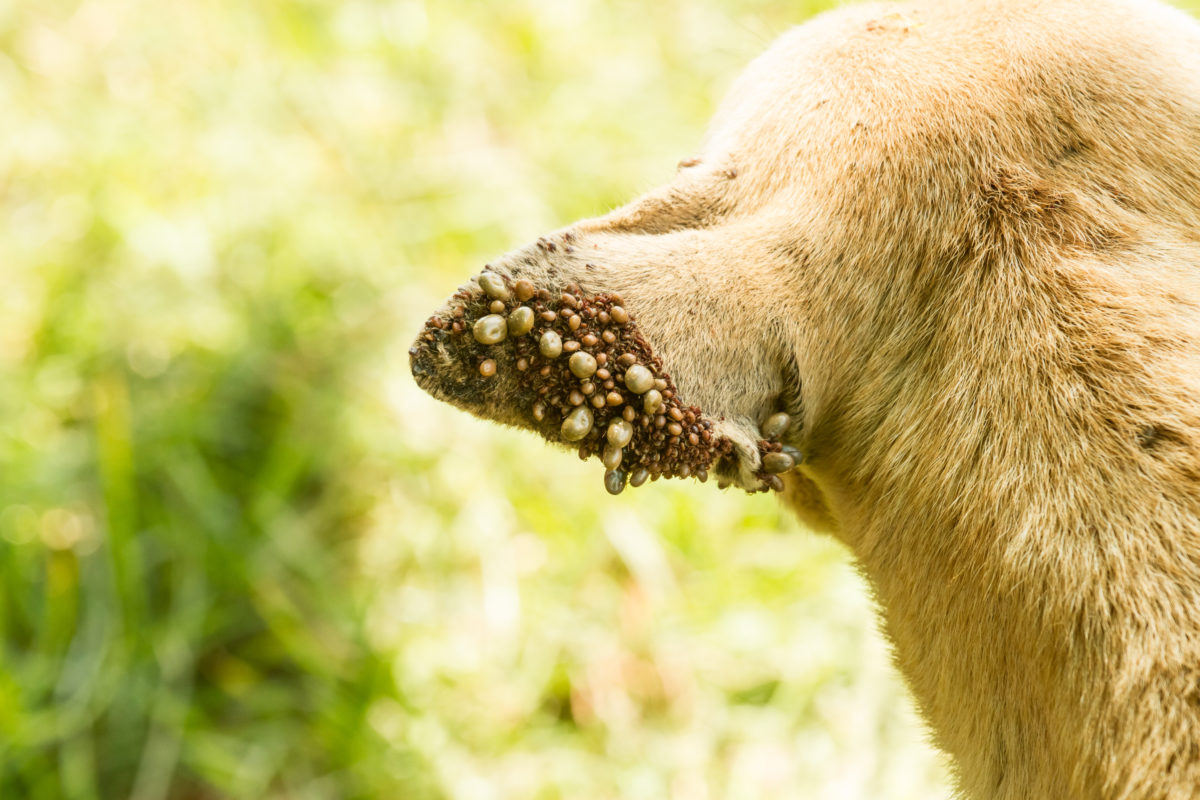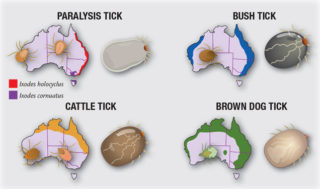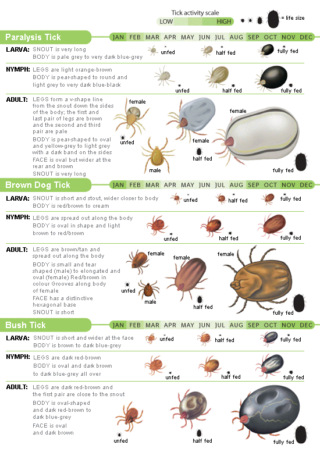Tick season is upon us

Most of us have heard of ticks and know that our pets can be affected, but should your pet be on a tick preventative?
There are a few different ticks in Australia that can be a nuisance for our pets, the Brown Dog Tick (Rhipicephalus sanguineus), the Bush tick and, most dangerously, the Paralysis Tick (Ixodes holocyclus). They can transmit diseases and the Paralysis Tick can cause a progressive lethal paralysis.
Ticks tend to be found in bushy areas and long grass near livestock or wildlife.

(image source: Virbac)

(image source: unknown)
Tick-borne diseases in Australia:
- Babesiosis
- A parasite that invades red blood cells, causing anaemia, weakness, lethargy, pale gums, red urine, yellowing skin, fever and possibly death
- Transmitted by the Brown Dog tick and possibly the Bush tick over several days, and also via dog bites
- Mostly in subtropical and tropical northern regions of Australia but has been found in southeastern Australia
- Dingoes can be infected and act as a reservoir for pet dogs
- Anaplasmosis
- An emerging disease most common in northern Australia
- A bacterial infection that affects the platelets (needed for blood clotting), causing fever, lethargy, weakness, pale gums and bleeding disorders
- Transmitted by the Brown Dog tick and possibly lice within 24-48 hours of attachment
- Ehrlichiosis
- Discovered May 2020 in a few dogs in the Gascoyne and Pilbara, WA, but now widespread through northern Western Australia and the Northern Territory. A locally acquired infection was found in Mt Isa, Queensland, in January 2022. This disease has the potential to spread much further.
- A bacterial infection causing fever, lethargy, swollen lymph nodes, loss of appetite, weight loss, pale gums and unusual bleeding or bruising
- Transmitted by the Brown Dog tick within 6-8 hours of attachment
- Found in subtropical and tropical regions worldwide
- A notifiable disease in Australia
- For more details, see www.outbreak.gov.au/current-responses-to-outbreaks/ehrlichiosis-dogs
The Paralysis Tick (Ixodes holocyclus):
- Whilst they can be around all year, they are most prevalent in late Winter and early Spring when the adult females are emerging to breed.
- Found along the east coast of Australia, not present in WA, NT or SA. (see map below)
- Signs of toxicosis include facial droopiness, weakness, cough, trouble breathing, inability to stand or walk and possible death
- The longer the tick is attached, the more severe the toxicosis and effects
- Treatment, if discovered early, requires tick antiserum and intensive care hospitalisation

(image source: unknown)
Luckily, we can help prevent these issues by:
Using a reliable tick preventative medication on your pet:
-
- Spot-ons, chews and tick collars are available, each with pros and cons for use. Chat to your vet about which suits your pet better and see our blog post on Parasite Preventatives for more information.
- Don’t be tempted to use ‘natural’ methods, the consequences of a tick bite can be disastrous so it’s worth investing in effective preventatives.
- Current veterinary advice for areas with Ehrlichia (NT, northern WA and northern Qld) is to use a tick repellent/killer (such as the Seresto collar) in combination with a preventative (such as Nexgard or Bravecto).
Order tick prevention online and protect your pet today – use code OBAY at checkout for free shipping.
If you are travelling or live in a tick prone area, check your pet thoroughly every day for ticks:
-
- The most effective technique is ‘finger-walking’ as ticks are easier to feel than see amongst your pet’s fur. This is done by starting at your pet’s nose and slowly walking your finger tips along the skin all over your pet’s body, being systematic and following the same pattern each time:
- Head – ticks like to hide in lip folds and ears, so check closely
- Neck
- Shoulders
- Front legs – especially between the toes and foot pads
- Back and tummy – hiding places include the arm pits and groin
- Back legs – between the toes and foot pads, again
- Bottom and genitals – double check under the tail and in any skin folds
- Tail
- Ticks can be tiny and easily missed, so checking daily may find a slightly bigger tick today that was missed yesterday.
- The most effective technique is ‘finger-walking’ as ticks are easier to feel than see amongst your pet’s fur. This is done by starting at your pet’s nose and slowly walking your finger tips along the skin all over your pet’s body, being systematic and following the same pattern each time:
Want a more thorough explanation? Check out our Tick Check Guide
Remove any ticks correctly and as soon as possible:
-
- Distract your pet with food or a treat
- Part the fur around the tick
- Using a tick removal device, grasp the tick as close as possible to your pet’s skin, then twist slowly and firmly to pull it away from the skin, trying to keep the tick intact.
- Pulling too quickly may cause the tick’s mouthparts to break off and remain in your pet’s skin. If this occurs, it can be removed with tweezers or by scratching with your fingernail.
- Tweezers are not recommended as a removal tool as they can squeeze the tick, causing more toxin to be injected into your pet.
- If you do not have a tick removal device, please call your veterinarian to have the tick removed as soon as possible. Waiting for the tick to drop off is not recommended as the longer it stays attached, the more likely that the paralysis toxin or infection has serious consequences.
One of our responsibilities as travelling pet owners is that we don’t contribute to spreading diseases and vectors (like ticks) further than their current endemic zone, so preventative actions are important not only for the health of your own pet but for all of us.
Keep your chosen parasite preventatives handy by storing them in your Vet in a Van – Navigator Pet First Aid Kit
*Note that tick preventatives may not be safe for all species (some dog medications are toxic to cats and rabbits), so please follow the label and seek veterinary advice before use.




